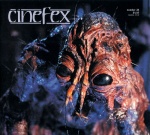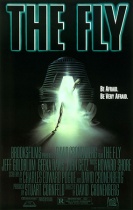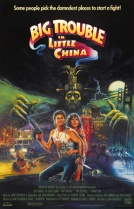 One glance at the front cover of Cinefex #28 should give you good reason to be afraid – very afraid. Staring right back at you is the grotesque visage of doomed scientist Seth Brundle following his metamorphosis into a half-human, half-insect hybrid at the climax of David Cronenberg’s horror classic The Fly (1986). Known to the crew as the ‘Space Bug’, this mutant creature was a full-scale puppet engineered by Chris Walas and his expert team. Flip to the back cover and there’s an animatronic character with a rather cuter demeanour: the runaway robot known as ‘Number Five’, star of John Badham’s movie from the same year: Short Circuit. This issue of Cinefex features three articles spanning 68 pages.
One glance at the front cover of Cinefex #28 should give you good reason to be afraid – very afraid. Staring right back at you is the grotesque visage of doomed scientist Seth Brundle following his metamorphosis into a half-human, half-insect hybrid at the climax of David Cronenberg’s horror classic The Fly (1986). Known to the crew as the ‘Space Bug’, this mutant creature was a full-scale puppet engineered by Chris Walas and his expert team. Flip to the back cover and there’s an animatronic character with a rather cuter demeanour: the runaway robot known as ‘Number Five’, star of John Badham’s movie from the same year: Short Circuit. This issue of Cinefex features three articles spanning 68 pages.
- The Fly Papers (article by Tim Lucas)
- Putting Big Trouble into Little China (article by Janine Pourroy)
- Building the Body Electric (article by Jody Duncan Shay)
The Fly
Just like its hero Seth Brundle, The Fly went through considerable metamorphosis before taking final shape. Unlike Brundle, it proved not only viable but also popular with both audiences and critics, grossing just over $60 million worldwide* – not bad given its R-rating.
 Thanks to extensive quotes from director David Cronenberg and producer Stuart Cornfeld, Tim Lucas is able to fill in plenty of background regarding the film’s early development. We even learn that the film’s iconic teleportation pods look exactly like the cylinders on Cronenberg’s Ducati motorcycle. But all that’s just a warm-up for the main event: an in-depth discussion of the film’s visual effects.
Thanks to extensive quotes from director David Cronenberg and producer Stuart Cornfeld, Tim Lucas is able to fill in plenty of background regarding the film’s early development. We even learn that the film’s iconic teleportation pods look exactly like the cylinders on Cronenberg’s Ducati motorcycle. But all that’s just a warm-up for the main event: an in-depth discussion of the film’s visual effects.
Most of the effects in The Fly are of a practical nature, featuring on-set illusions rather than optical wizardry. For instance, to allow actor Jeff Goldblum to crawl up walls, production designer Carol Spier and construction manager Kirk Cheney built ingenious inclined and rotating sets. The lion’s share of Lucas’s text, however, is devoted to the Oscar-winning work of special makeup creator Chris Walas and his crew.
Walas’s contributions ranged from the Stage I makeup, which used ‘dabs of red, burgundy, yellow and blue makeup to discolor Goldblum’s face, which was also dotted with tiny fly hairs’, through Stages II and III (featuring plastic warts, disintegrating body parts and ‘fly goop’) all the way to the full-body suits of Stages IV and V. For the final stages of the transformation, makeup was abandoned in favour of John Berg’s remarkably expressive full-scale puppets.
Walas leaves no part of Seth Brundle’s anatomy untouched: skin, teeth, hair and eyes. He also reveals a number of trade secrets, like the way an entire set wall was sanded smooth to stop it shredding the delicate foam-latex makeup appliances, or how extra grip was applied to Goldblum’s false hands and feet to give them ‘the grainy tread of a snow tire.’ Goldblum was so patient with the whole uncomfortable process that Walas calls him, ‘a special effects makeup man’s dream come true.’
Walas and Berg also provide some insights into the thought processes behind their work. Walas in particular comes across as a diehard innovator, with some of his comments reminding us that even back in 1986 certain visual effects were getting stale. Specifically: transformation scenes. ‘Forget it!’ he says, using the werewolf metamorphosis from Joe Dante’s The Howling (1981) as an example. ‘They’ve been done … we consciously tried to avoid the standard cliche of stretching rubber by trying something new.’
So, next time you sit in the cinema moaning that all these giant robots and Massive crowd simulations look the same, and that things were better in the old days, remember that every era spawns not only innovation, but its fair share of imitation too.
(Visual effects have moved on since 1986. So has teleportation. What was once the stuff of science fiction is now science fact, with scientists zapping quantum-entangled photons here, there and everywhere. If you don’t believe me, here’s a National Geographic article from 2004. I just hope they kept a can of Raid next to the machine …)
Big Trouble in Little China
At first glance, the effects in Big Trouble in Little China appear all very 1980s stock-in-trade: glowing energy trails, animated lightning, bizarre animatronic creatures … it all has a kind of reheated Ghostbusters vibe. Leafing through Janine Pourroy’s article, I wondered if visual effects supervisor Richard Edlund had been rather sitting on his laurels when he took the project on.
How wrong I was.
 Like Chris Walas, Edlund once more declares his passion for breaking new ground. ‘Whenever we [at Boss Film] get involved with special effects for a picture,’ he says, ‘it’s very important for us to add something that hasn’t been seen before … It’s our responsibility to … develop a special “look” [for the film] that makes it stand out as something unique.’
Like Chris Walas, Edlund once more declares his passion for breaking new ground. ‘Whenever we [at Boss Film] get involved with special effects for a picture,’ he says, ‘it’s very important for us to add something that hasn’t been seen before … It’s our responsibility to … develop a special “look” [for the film] that makes it stand out as something unique.’
The lightning effects are a good example of how Edlund’s team added a new twist to a familiar concept. Instead of using backlit art and adding diffusion in the optical printer, animation supervisor Garry Waller favoured toplit art, with coloured glows airbrushed in frame by frame. It was a laborious approach but, according to Waller, it ‘gave the lightning a lot of nice crackle and glow – it truly looked electrical.’
As for the scene where supernatural villain Lo Pan transforms on-camera from wizened old man to youthful warrior, special makeup effects artist Steve Johnson is clearly singing from the same hymn sheet as Walas. ‘It’s different from the typical “change-o” kind of stuff that’s been done ever since American Werewolf,’ he says, referring to the internally-lit animatronic head that gave the illusion its eerie, X-ray quality.
We’re back on familiar ground with the wildman monster – ‘basically a Greystoke suit using the same technology Rick Baker had worked out’ – but Edlund’s ingenuity came up trumps again when he devised a donut-shaped bluescreen that enabled his crew to operate a ‘flying medicine ball-sized sphere dotted with eyes’ entirely from behind, eliminating the need for cumbersome puppeteering rigs that would need rotoscoping out.
The film’s short production schedule made things tough on the Boss team. Pourroy documents the challenges of 24/7 rotoscoping to realise the spirit-warrior fight scene, and of the initial, failed attempt to create a likeness of actor Carter Wong for the scene where his character Thunder inflates like a balloon before finally exploding. And optical supervisor Bill Neill is tough on himself when talking about the clumsiness with which the flying eye was sometimes integrated into the live-action plates.
For the most part, however, this is a story of success … though against the odds. ‘We made this movie … like a low budget film,’ says director John Carpenter, ‘just running gun.’ Even so, Carpenter found time to indulge himself on the set. When shooting the inflating head scene, Steve Johnson says, ‘Carpenter kept egging me on to pop [the head], to go as far as we could inflating it and just see what happened … but at the last minute I just figured that was close enough.’
Shame. That would have been one heck of an outtake.
Short Circuit
The final article in Cinefex #28 is Jody Duncan Shay’s piece on John Badham’s Short Circuit, another popular hit from the mid-80s. The movie’s big challenge was to create a robot character called Number Five capable of delivering a performance on a par with its human co-stars. No mean feat, given the director was against the obvious stop-motion solution (increasingly seen as an outdated technique). The man chosen over Apogee, ILM and Carlo Rambaldi was a relative unknown called Eric Allard. ‘I told them the last thing they wanted was a real robot,’ Allard says, ‘which I think is what sold them on my concept.’
 Working from designs by Syd Mead, Allard developed ‘no less than twenty-seven action props’ – these included radio-controlled versions, partial puppets and simple dummies, together with an array of close-up hands and arms. Allard walked the tightrope between interpreting Mead’s drawings and producing workable puppets capable of interpreting the script. ‘It was pretty intense,’ he says.
Working from designs by Syd Mead, Allard developed ‘no less than twenty-seven action props’ – these included radio-controlled versions, partial puppets and simple dummies, together with an array of close-up hands and arms. Allard walked the tightrope between interpreting Mead’s drawings and producing workable puppets capable of interpreting the script. ‘It was pretty intense,’ he says.
The article breaks down the construction of the robot components in all its dizzying glory, from high-impact styrene to teflon impregnated delron and beyond. Duncan Shay rewards our attention to the detail with a number of on-set anecdotes, including the spooky moment when one of the fifteen duplicate robots malfunctioned. ‘Believe it or not,’ says Allard, ‘the first one that short-circuited was number five … After we rebuilt it, it ended up being the best, most reliable robot we had for the duration of the show.’
Much attention is given to Tony Urbano and ‘his crew of roboteers – Tim Blaney, Carl Johnson and Rico Topazio’. Urbano gives insight into the puppet techniques he and his team employed, including ‘basic animated cartoon theory – starting with a good beginning pose, finding a great ending … and then in-betweening them.’ He’s also complimentary about Badham: ‘John was extremely patient and he encouraged us to take this thing to its limit.’
Deeper into the article, Duncan Shay gets specific with breakdowns of NumberFive’s more challenging pieces of choreography: making pancakes, flipping a metal washer like George Raft and, of course, the disco-dance sequence in which Number Five replicates some of John Travolta’s famous moves from Badham’s own Saturday Night Fever.
Badham seems delighted with what his effects team achieved, particularly in terms of value for money. With the total budget for Number Five coming in at $1.4 million, he concludes, ‘It was a bargain … Eddie Murphy would have cost us twice as much. And, unlike Eddie Murphy, we can use him again.’
The pictures
And so to this issue’s pictures. The behind-the-scenes shots from The Fly showcase the work of Chris Walas and Jon Berg in all its gory glory, with pages of photos revealing large puppet crews crouched barely out of shot, hauling cables and working rods. The best of these shows a bespectacled Chris Walas lying on the studio floor wearing glove-like creature arms and holding a severed foot, while a puppet Brundle leans over him ready to suck up its victim’s liquidised remains.
From the Big Trouble in Little China article, I’ve picked another makeup effect, this time a rear view of the full-body inflating Thunder suit. The suit is open at the back, revealing a pair of weather balloons and about a billion cables and air pipes.
The Short Circuit article features some great shots of Number Five under construction. In the spirit of the other photos I’ve picked, my favourite has to be the big colour shot on page 61 that shows actress Ally Sheedy sharing a scene with her robotic co-star. From the waist up, Number 5 looks fine, but his lower half just dissolves into a four-man crew of ‘roboteers’ intent on their waldos, radio controllers and video monitors.
Cinefex #28 is another one of those issues that gives performance the same weight as technical excellence. Job Berg sums things up when he describes the puppets he created for The Fly as ‘condensers for the human element behind them … it’s the essence of people putting their energy and sympathy into the thing.’
Berg goes on to define his work as ‘something [that] can produce an effect on the audience.’ I like his choice of words. He reminds us that the term ‘visual effect’ refers not to some clever technological process, but to the feeling it invokes in the viewer. This isn’t the first time Cinefex has shown us an effects artist emphasising the importance of audience reaction, and I’m sure it won’t be the last.
*Figure from Box Office Mojo
Did you enjoy this Cinefex retrospective? If so, click here to read the others in the series.

So much fun to revisit these old issues (made all the sweeter for the memories they bring). Thank you, Graham!
My pleasure, Janine. Rest assured it’s a lot of fun for me too 🙂